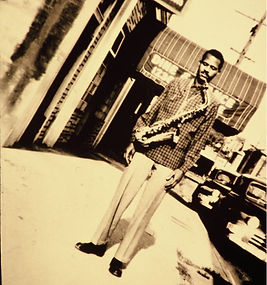

Entertainer’s Cabaret
(aka the Que Club, Cotton Club
and Sessions Playhouse
1238 S. Main St.
As you look north across the playfield of Bailey Gatzert Elementary School, imagine the whole area filled with wooden buildings spread out over several blocks, not just one mega-block with a school. (See the historic map). In front of you would have been the Entertainer’s Cabaret, where in August 1920, the great New Orleans pianist and composer Ferdinand “Jelly Roll” Morton performed. Morton had been working in Vancouver, B.C., with pianist and clarinetist Oscar Holden — who would later move to Seattle — so it’s possible Morton and Holden played at the Entertainer’s together.
When Morton tickled the keys at the Entertainer’s, he was not yet world famous — his first recordings were made in Chicago in 1923 — but he was highly respected by musicians as well as players in “the sporting life.” A flamboyant hustler with a diamond embedded in one of his front teeth, Morton was the first important composer in jazz. He penned an affectionate nod to his Northwest period with a rag called “Seattle Hunch.”
The Entertainer’s Cabaret opened in 1919, when it first advertised “up-to-date music” in the Black newspaper Cayton’s Weekly. A year later, the paper ran an ad promising “Thousands of Barrels of Refreshing … Music,” a not-so-subtle allusion to the free flow of alcohol during Prohibition.

Ad from Cayton’s Weekly, August 7, 1920, around the time Jelly Roll Morton played there.
The Entertainer’s Cabaret, in 1937, when it was known as the Cotton Club. The name is printed in white letters on the windows on either side of the front door. The entrance to the hotel rooms upstairs is on the left. (Source: Washington State Archives, Puget Sound Regional Branch)
![Entertainer's Caberet aka Cotton Club 859240-0115,_stores,_1937[1].tif](https://static.wixstatic.com/media/b4878d_d1b5a5395617417ca0ea18084e8c953e~mv2.png/v1/crop/x_127,y_0,w_945,h_708/fill/w_526,h_389,al_c,q_85,usm_0.66_1.00_0.01,enc_avif,quality_auto/Entertainer's%20Caberet%20aka%20Cotton%20Club%20859240-0115%2C_stores%2C_1937%5B1%5D_tif.png)

Roscoe Weathers standing in front of Sessions, c. 1948. When Costanza Romero was designing the costumes for the Seattle premiere of her husband August Wilson’s play Seven Guitars, she used Roscoe’s shirt and slacks as a model for one of the characters.
(Courtesy of Wanda Brown)
This venue, as 1238 S. Main St., went through many incarnations. In 1927, it was known as Liberty Hall, home of the United Negro Improvement Association, then in 1932 returned to the world of night life as the Que Club. From 1933 to 1937, it was called the Cotton Club. One of its most illustrious heydays began on February 2, 1946, when it reopened as Sessions Playhouse. In keeping with a trend that also caught on at Basin Street (Stop 8) and the Black and Tan (Stop 16), Sessions presented racy floor shows with scantily clad dancing girls and bawdy comics before the music came on.
“We’d go in there and play for people like Zenobia,” recalled Oregon-born trumpeter Floyd Standifer (1929-2007), referring to one of Seattle’s most popular exotic dancers. “Or George Bernie, a cat who’d pick up a table with his teeth. After these little acts, we’d ‘chase’ the act off with ‘Lester Leaps In.’ That’s why they call it a ‘chaser.’ Variety entertainment.”
Alto saxophonist Roscoe Weathers (1920-1985?), another important musician in Seattle, also played here. Originally from Memphis, Weathers appears to have come to Seattle with Kansas City band leader Jay McShann in 1945; he claimed to have known Charlie Parker in McShann’s band. He was definitely the first jazz musician on the Seattle scene fluent in the new bebop style pioneered by Parker. Pianist Ken Boas remembered Weathers as being so moved by hearing Parker on a jukebox one night that he began to weep.
“I said, ‘What’s the matter?’ And he said, ‘Oh, you don’t understand. Those guys, it’s just like they were praying.’”
Weathers later moved to Los Angeles, but the Sessions carried on. In 1951 it was known simply as the Playhouse. The following year the Royal Esquires, a Black social club that still exists today, hosted Louis Armstrong and His All-Stars at the venue as guests of honor for a March of Dimes fundraiser. In 1954, the venue was operating as the Cosmopolitan Athletic Club, which stayed in business until at least 1958.

Ads from the Northwest Enterprise.

Exotic dancers were a specialty.
Behind the Entertainer’s, facing a slice of South Washington Street that no longer exists, was Finnish Hall, where swing bands led by stars like Fletcher Henderson once performed. While small clubs like the Sessions Playhouse couldn’t sell enough tickets to present nationally famous artists, independent promoters and organizations regularly presented name acts at Finnish Hall. From 1931 through 1956, swing fans jitterbugged on the grand hall’s maple dance floor to the strains of Black big bands led by Louis Armstrong, Earl Whaley, Cecil Finley, Gene Coy, Eli Rice, Erskine Hawkins, Fletcher Henderson, Noble Sissle, Jimmie Lunceford, Red Allen and Lucky Millinder. Local leaders Evelyn Bundy-Taylor, Al Pierre, Joe Darensbourg and Palmer Johnson played there as well. In the 1950s, the stage at Finnish Hall hosted dramas by the Contemporary Players. Like the Entertainer’s Cabaret and the Rocking Chair, around the corner, it was torn down. Bailey Gatzert Elementary School, previously at another location, was built here in 1988.
![Finnish Hall hi res 859190-0005,_apartment,_1937[1].tif](https://static.wixstatic.com/media/b4878d_9c7ec80cacde49bc8fbc0ea60b187ad3~mv2.png/v1/fill/w_600,h_351,al_c,q_85,usm_0.66_1.00_0.01,enc_avif,quality_auto/Finnish%20Hall%20hi%20res%20859190-0005%2C_apartment%2C_1937%5B1%5D_tif.png)
Finnish Hall, 1937. Built in 1923, Finnish Hall hosted spectacular dances by local and national acts throughout the 1930s and ’40s. The name of the hall is visible above the door, partially obstructed by a power pole.
(Source: Washington State Archives, Puget Sound Regional Branch)

Map showing the location of Sessions Playhouse, highlighted in yellow, Finnish Hall (red), and the Rocking Chair (blue), where Ray Charles became a local institution. Bailey Gatzert and its playfield now occupy all of this land.
(Sanborn Maps, Seattle 1905-Mar. 1951, Vol. 1, 1916-Apr. 1950, Sheet 19.)

Bird’s eye view of Bailey Gatzert School playfield, 2024. Yellow highlight shows where the Entertainer’s Cabaret once was.